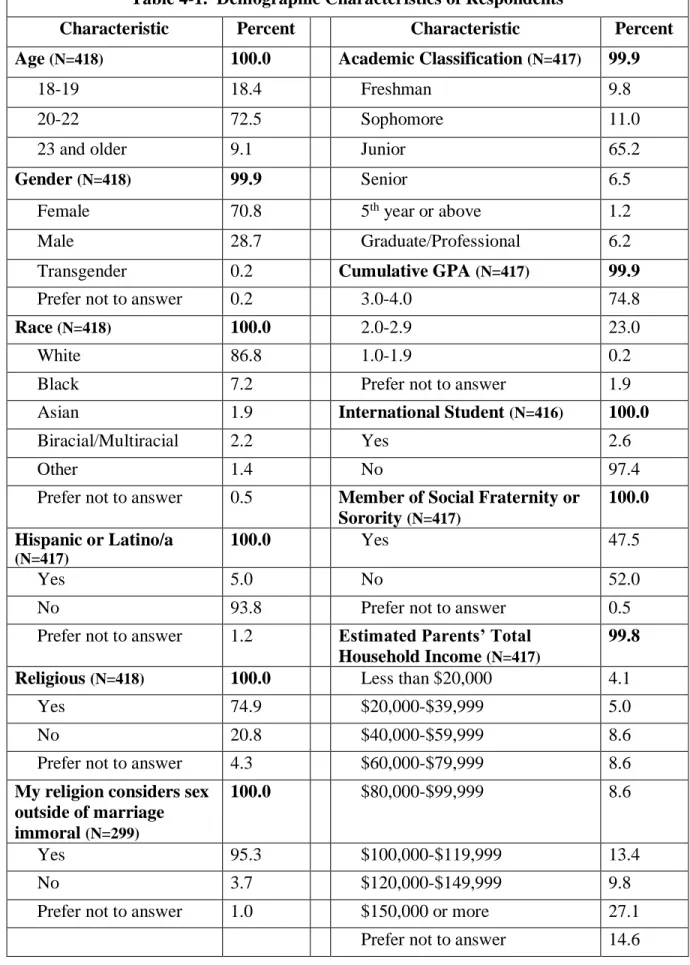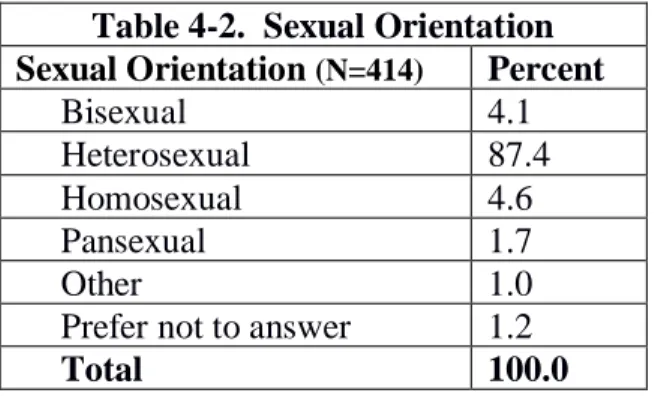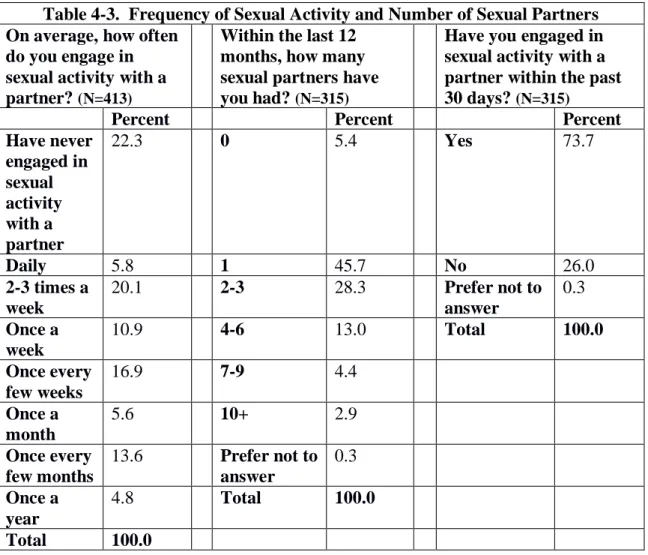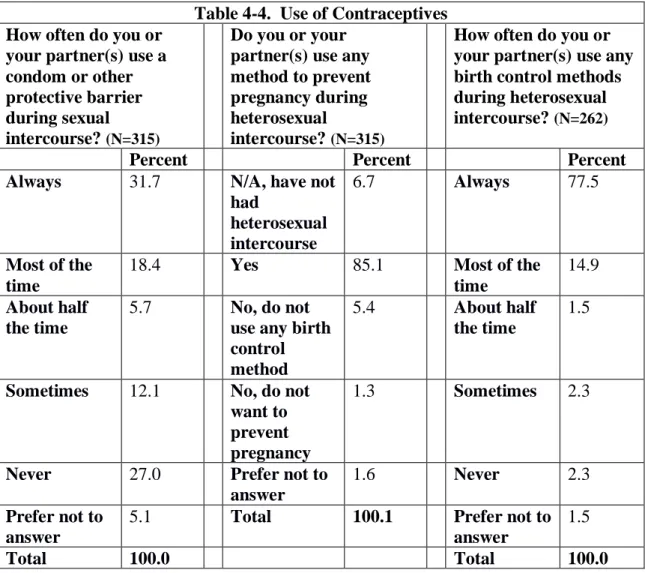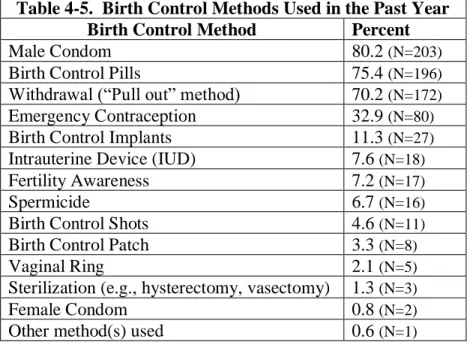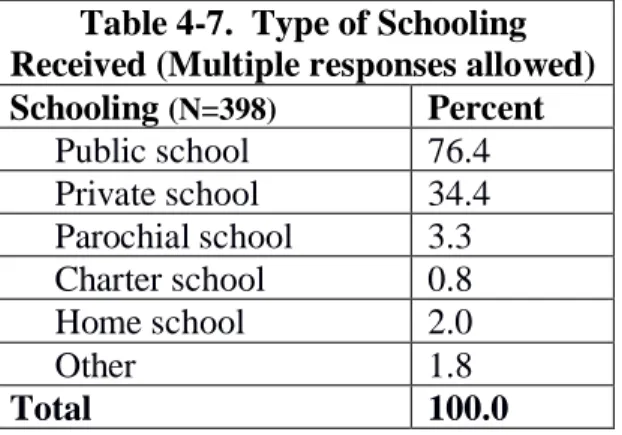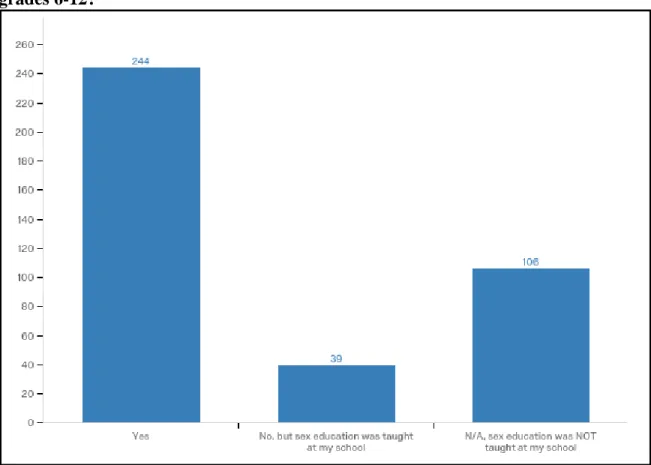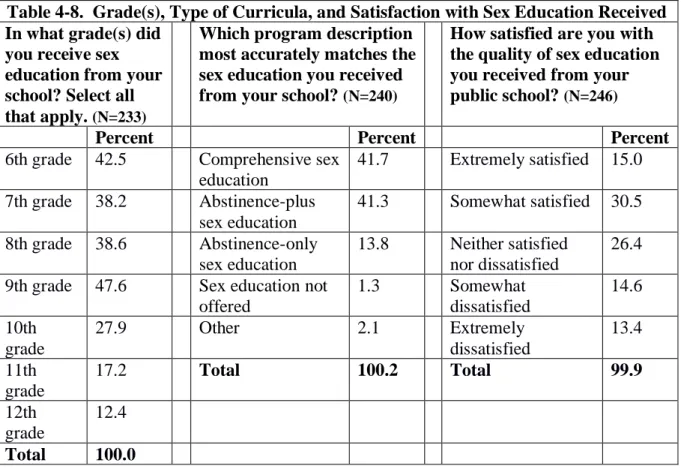The data indicate that students were more likely to be satisfied with comprehensive sex education. The main purpose of this study is to understand University of Mississippi (UM) students' opinions regarding sex education policies in Mississippi public schools. Third, I wanted to measure UM students' opinions about sex education policies in Mississippi public schools, which was the primary purpose of this.
LITERATURE REVIEW
Currently, the federal government provides funding for both comprehensive and abstinence-only sex education programs. According to the Guttmacher Institute, 24 states and the District of Columbia require some form of sex education. The purpose of the study was to examine the opinions of Mississippi parents regarding sex education in Mississippi public schools.
METHODOLOGY
Institutional research, effectiveness, and design to obtain a representative sample of the student body at the University of Mississippi. Respondents were first asked to answer demographic questions to create an accurate representation of the respondent group. All demographic information of the surveyed group is presented in Table 4-1 on the next page.
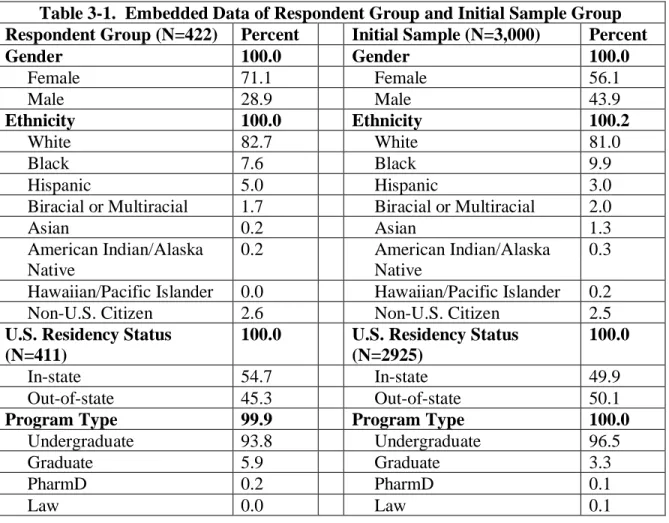
How often do you or your partner(s) use any birth control methods during heterosexual intercourse.
The respondents were then asked whether or not they had participated in a sex education course at school in groups 6 to 12 (number of respondents: 389). Respondents were allowed to provide more than one answer if they participated in sex education courses in multiple grades. These respondents were then asked to indicate how satisfied they were with the quality of the sex education they received at their school.
Respondents were first asked a simple “Yes” or “No” question about whether they believed sexuality education should be taught in Mississippi's public school system (Number of respondents: 379). Respondents were then asked in which classes, in their opinion, age-appropriate sex education should be taught, assuming that sex education is taught. Respondents could give multiple answers if they believed that sexuality education should be offered in more classes.
Respondents were then given two 5-point Likert-scale matrix questions in which they were asked to indicate the extent to which they agreed or disagreed with various topics included in public school sex education curricula. Determining student enrollment and material taught in sexuality education courses Assuming that sexuality education is taught. Respondents were then given another 5-point Likert-scale matrix question in which they had to indicate the extent to which they agreed or disagreed with certain statements regarding sexuality education.
When asked whether sex education should be taught in Mississippi public schools, 97.1% (N=368) of all respondents answered "Yes".
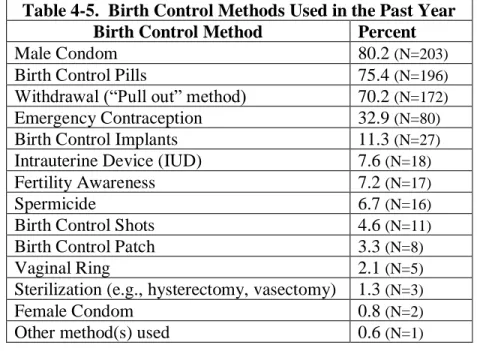
97.6% of conservatives agreed that sex education courses should include information about contraceptive methods (an element of comprehensive sex education curriculum), compared to 97.4% of moderates and 100.0% of liberals. Another crosstab was created to determine if there was a relationship between the type of sexuality education respondents received from their school and their levels of satisfaction with the sexuality education they received. Among those who received comprehensive sexuality education from their school, 65.0% (N=65) reported satisfaction, while 8.0% (N=8) reported dissatisfaction.
Among those who received abstinence-only sex education from their school, 12.1% (N=4) indicated they were satisfied while 72.7% (N=24) indicated they were dissatisfied. Another cross-tabulation was created to determine the relationship between the type of sex education received and whether or not respondents attended school in Mississippi. 54.4% (N=105) of respondents who attended school in Mississippi participated in a sex education course and 35.8% (N=69) of respondents who attended school in
70.9% (N=139) of respondents who did not attend school in Mississippi attended a sex education course, while 18.9% (N=37) of respondents who did not attend school in Mississippi indicated, that sex education was not offered at their school. Among those who attended a sexuality education course, 52.3% (N=67) of respondents who did not attend school in Mississippi in grades 6-12 received comprehensive sexuality education, compared to 31.7% (N=33) of the respondents who attended school in Mississippi. Interestingly, a majority of respondents who attended schools in Mississippi in grades 6-12 received abstinence plus sex education (50.0%; N=52), compared to 36.7% (N=47) of those who didn't go to school in Mississippi.
Additionally, only 18.3% (N=19) of respondents who attended school in Mississippi during grades 6-12 received abstinence-only sex education, but this was still greater than respondents who did not attend school in Mississippi as only 10.9% (N =14) received abstinence-only sex education.
Total 99.9
DISCUSSION & POLICY RECOMMENDATIONS
In addition, 45.5% (N=112) of UM students indicated that they were satisfied with the sexuality education they received, while 28.0% (N=69) indicated that they were dissatisfied. The main takeaway from the results is that an overwhelming majority of UM students (97.1%) believe that sex education should be taught in Mississippi's public school system. This suggests that respondents further favored comprehensive sex education over abstinence plus sex education.
For example, 92.1% of Mississippi parents thought that sex education should be taught in public schools compared to 97.1% among UM students (McKee et al., 2011). Furthermore, only 17.0% agreed with the state's enrollment policy for enrolling students in sex education courses. First, an overwhelming majority of UM students (97.9%) think that state law should require that the material taught in sex education courses be medically accurate.
Furthermore, they must ensure that students have access to sex education in middle school (grades 6-8) and high school (grades 9-12). Most importantly, UM students overwhelmingly support teaching sexuality education in Mississippi public schools and favor elements of comprehensive sexuality education. Politically, UM students are more conservative than college students nationally, but this does not affect their support for comprehensive sex education.
Additionally, policies at all levels should increase access to comprehensive sex education in Mississippi public schools, based on the preferences of UM students and Mississippi parents.
CONCLUSION
The third and primary research question was to measure the opinions of UM students on sex education policies in Mississippi public schools. Additionally, an overwhelming majority supported elements of the comprehensive sex education curriculum, such as providing information about birth control methods and teaching students how to use condoms properly through classroom demonstrations. Most students also disagreed with the current requirements of Mississippi's sex education law, such as the "opt-in" policy for enrolling students in sex education courses, as well as the primary role played by state lawmakers in determining specific content requirements.
The first goal was to measure the political views of UM students to see if students' political views were related to their opinions about sexuality education. The results found that more UM students identified with the Republican Party and as ideologically conservative than anything else, but this had little to do with their opinions about sex education. With this goal in mind, I plan to share the results of this study with relevant policy organizations that have a concern for sexuality education policy in Mississippi such as Mississippi First and the Mississippi Women's Foundation.
Mississippi's sex education policies and their expressed preferences regarding those policies, I encourage concerned UM students to become more politically engaged so that state and local policymakers will hear their opinions. Therefore, I strongly encourage similar surveys to be conducted in the future to determine the opinions of college students across Mississippi regarding the state's sex education policies. Furthermore, because the literature on Mississippi's sexuality education policy is limited to Mississippi parents, teachers, and students, I encourage future researchers to measure the opinions of other relevant populations about Mississippi's sexuality education.
With a complete picture of the opinions of Mississippi college students as well as other relevant groups regarding sex education policies in Mississippi, I believe that policymakers will be able to create better sex education policies for the benefit of Mississippi public school students.
ADDITIONAL TABLES
Abstinence-only classes are effective in preparing students to wait until they are married before having sex. Abstinence-only courses are effective in making students wait until they are older to start having sex. Students in abstinent classes are less likely to use contraception if they have sex.
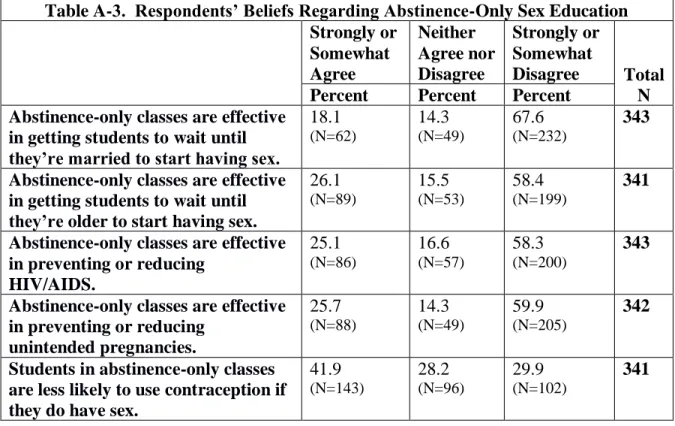
SURVEY RECRUITMENT EMAIL Email Subject: Survey on Sex Education Opinions
QUALTRICS DATA REPORT
Abstinence-only sex education ("Programs that emphasize abstinence from all sexual behavior. These programs do not include information about contraception or disease prevention methods."). Q31 - How satisfied are you with the quality of sex education you received from your public school. Q32 - Please briefly explain your level of satisfaction with the quality of sexuality education you received from your school.
Question 35 - Assuming that sex education is taught in Mississippi public schools, at what grade level do you think (age-appropriate) sex education should be taught. Question 36 - Assuming that sex education is taught in Mississippi public schools, please indicate to what extent you are agree or disagree that the following topics should be included in public school sex education courses. Question 37 - Assuming that sex education is taught in Mississippi public schools, please indicate the extent to which you agree or disagree that the following topics should be included in public school sex education courses.
Q38 - Assuming that sex education is offered in public schools in Mississippi, please indicate to what extent you agree or disagree with the following statements regarding sex education. State law must require that all information provided in sex education classes be medically accurate. Q39 - Assuming that sex education is offered in public schools in Mississippi, how should student enrollment in sex education courses be determined.
Question 40 - Assuming that sex education is taught in Mississippi public schools, who do you think should determine the material taught in sex education classes. Question 43 - Comprehensive sexuality education programs "include age-appropriate, medically accurate information on a broad set of topics related to sexuality, including human development, relationships, decision-making, abstinence, contraception, and disease prevention." (SIECUS) Please indicate to what extent you agree or disagree with the following statements. Comprehensive sex education classes are effective in getting students to wait until they are older to start having sex.
